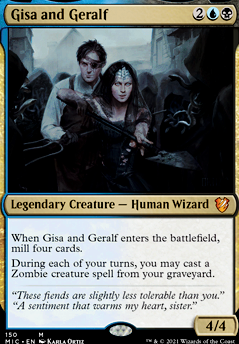
The Five Laws of NecroWarfare: A ZomboCombo Primer
Commander / EDH* Combo Infinite Combo Primer Tribal UB (Dimir) Zombie
Moorlands (Land) (36)
- 1x Choked Estuary
- 1x Command Tower
- 1x Drowned Catacomb
- 1x Gemstone Caverns
- 1x High Market
- 11x Island
- 1x Phyrexian Tower
- 1x Polluted Delta
- 1x Sunken Ruins
- 11x Swamp
- 1x Temple of Deceit
- 1x Underground River
- 1x Underground Sea
- 1x Urborg, Tomb of Yawgmoth
- 1x Volrath's Stronghold
- 1x Watery Grave
Genius and Madness (Combo) (7)
- 1x Bitter Ordeal
- 1x Brain Freeze
- 1x Cloudstone Curio
- 1x Gravecrawler
- 1x Rooftop Storm
- 1x Sedraxis Alchemist
- 1x Tendrils of Agony
Whistling (Recursion) (7)
Decisions, Decisions (Removal and Control) (15)
- 1x Arcane Denial
- 1x Counterspell
- 1x Cryptic Command
- 1x Curse of the Swine
- 1x Cyclonic Rift
- 1x Damnation
- 1x Fleshbag Marauder
- 1x Muddle the Mixture
- 1x Nevinyrral's Disk
- 1x Pact of Negation
- 1x Reality Shift
- 1x Stronghold Assassin
- 1x Swan Song
- 1x Toxic Deluge
- 1x Tragic Slip
Graverobbing (Tutors) (8)
- 1x Buried Alive
- 1x Corpse Connoisseur
- 1x Corpse Harvester
- 1x Demonic Tutor
- 1x Diabolic Intent
- 1x Entomb
- 1x Lim-Dul's Vault
- 1x Sidisi, Undead Vizier
Nephalian Treasures (Ramp) (6)
Commander (1)
A Consequence of Practice (Card Draw) (12)
- 1x Corpse Augur
- 1x Cryptbreaker
- 1x Custodi Lich
- 1x Dig Through Time
- 1x Fact or Fiction
- 1x God-Eternal Bontu
- 1x Graveborn Muse
- 1x Midnight Reaper
- 1x Notion Rain
- 1x Phyrexian Arena
-
1x
Rhystic Study

- 1x Skullclamp
Ready to Serve (Misc. Value) (4)
Stitching (Sac Outlets) (4)
Maybeboard
Suggestions
Comments View Archive
Attention! Complete Comment Tutorial! This annoying message will go away once you do!
Important! Formatting tips — Comment Tutorial — markdown syntax
Please login to comment
Revision 18 See all
(4 years ago)
| +1 | Ashiok, Dream Render | maybe |
| +1 | Chain of Vapor | maybe |
| +1 | Deadly Rollick | maybe |
| +1 | Deep Analysis | maybe |
| +1 | Drown in the Loch | maybe |
| +1 | Epic Downfall | maybe |
| +1 | Foulmire Knight | maybe |
| +1 | Gift of Doom | maybe |
| +1 | Gravebreaker Lamia | maybe |
| +1 | Mox Amber | maybe |
| +1 | Skinthinner | maybe |
| +1 | Thassa's Intervention | maybe |
| +1 | Windfall | maybe |
| +1 | Wishclaw Talisman | maybe |
| +1 | Witching Well | maybe |
| Top Ranked |
|
| Date added | 7 years |
| Last updated | 4 years |
| Legality | This deck is Commander / EDH legal. |
| Rarity (main - side) | 6 - 0 Mythic Rares 43 - 0 Rares 16 - 0 Uncommons 13 - 0 Commons |
| Cards | 100 |
| Avg. CMC | 2.94 |
| Tokens | Bird 2/2 U, Boar 2/2 G, Copy Clone, Manifest 2/2 C, The Monarch, Zombie 2/2 B |
| Folders | NetDecks, commander decks, Look at these brewmasters!, EDH, Future Zombie deck to build, Commander, Stuff I like, Commander Folder, Modern decks, Me like |
| Votes | |
| Ignored suggestions | |
| Shared with | |
| Views |











